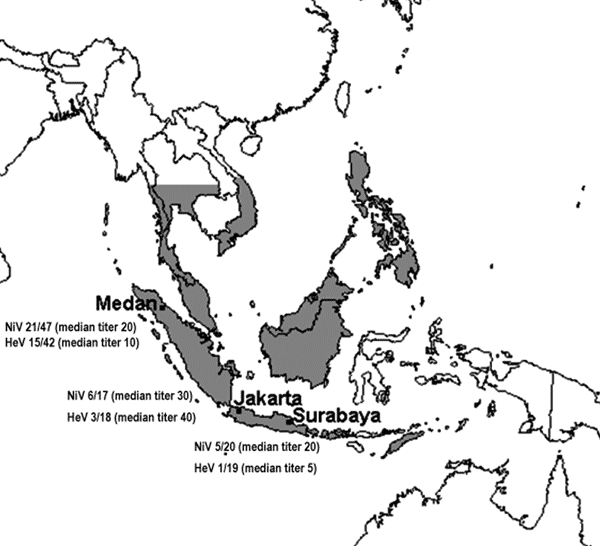Volume 12, Number 4—April 2006
Letter
Henipavirus in Pteropus vampyrus Bats, Indonesia
Figure

Figure. Geographic range of Pteropus vampyrus (5) and proportion of bats whose sera neutralized Nipah virus (NiV) and Hendra virus (HeV) at each location. Numbers are given as the ratio of the number of positive samples to the total number of positive and negative samples (excluding bats in which a toxic reaction precluded a definitive test outcome and bats that had inadequate samples for neutralization testing).
References
- Chua KB, Bellini W, Rota P, Harcourt B, Tamin A, Lam S, Nipah virus: a recently emergent deadly paramyxovirus. Science. 2000;288:1432–5. DOIPubMedGoogle Scholar
- Murray K, Selleck P, Hooper P, Hyatt A, Gould A, Gleeson L, A morbillivirus that caused fatal disease in horses and humans. Science. 1995;268:94–7. DOIPubMedGoogle Scholar
- Yob JM, Field H, Rashdi A, Morrissy C, van der Heide B, Rota P, Nipah virus infection in bats (order Chiroptera) in peninsular Malaysia. Emerg Infect Dis. 2001;7:439–41.PubMedGoogle Scholar
- Chua KB, Koh C, Hooi P, Wee K, Khong J, Chua B, Isolation of Nipah virus from Malaysian Island flying foxes. Microbes Infect. 2002;4:145–51. DOIPubMedGoogle Scholar
- Micklesburg S, Hutson A, Racey P. Old World fruit bats: an action plan for their conservation. Gland (Switzerland): Internation Union for the Conservation of Nature and Natural Resources; 1992.
- Daniels P, Ksiazek T, Eaton B. Laboratory diagnosis of Nipah and Hendra virus infections. Microbes Infect. 2001;3:289–95. DOIPubMedGoogle Scholar
- Smith C, Epstein J, Rahman S, Field H, Sharifah S, Daszak P. Use of satellite telemetry to study the movement of the Malayan flying fox (Pteropus vampyrus): implications for conservation and public health [abstract 89]. In: Wildlife health in a shrinking world: ecology, management and conservation. From the proceedings of the International Wildlife Diseases Association conference; Cairns, Australia; June 2005. p. 168. Available from http://www.rainforest-crc.jcu.edu.au/events/ WildlifeDiseasesAssocConf/WDA%20Book%20of%20Abstracts%20-%20WEB.pdf
- Field H, Young P, Yob JM, Mills J, Hall L, Mackenzie J. The natural history of Hendra and Nipah viruses. Microbes Infect. 2001;3:307–14. DOIPubMedGoogle Scholar
- Olson JG, Rupprecht C, Rollin P, An U, Niezgoda M, Clemins T, Antibodies to Nipah-like virus in bats (Pteropus lylei), Cambodia. Emerg Infect Dis. 2002;8:987–8.PubMedGoogle Scholar
- IDDR. B Centre for Health and Population research. Person-to-person transmission of Nipah virus during outbreak in Faridpur District, 2004 [monograph on the Internet]. Health and Science Bulletin. 2004 [cited 2006 Feb 17]. Available from http://202.136.7.26/pub/publication.jsp?classificationID=56&pubID=5252
Page created: January 24, 2012
Page updated: January 24, 2012
Page reviewed: January 24, 2012
The conclusions, findings, and opinions expressed by authors contributing to this journal do not necessarily reflect the official position of the U.S. Department of Health and Human Services, the Public Health Service, the Centers for Disease Control and Prevention, or the authors' affiliated institutions. Use of trade names is for identification only and does not imply endorsement by any of the groups named above.